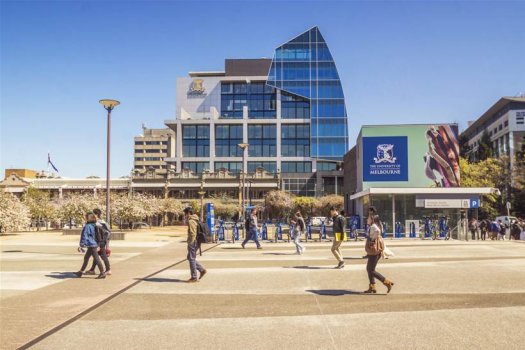K
Kathleen Martin
Guest
Australian universities are not only using the Internet of Things (IoT) in their research – some have also been using the technology to provide safer environments for thousands of students and staff members.
This includes at the University of Melbourne, which saw a need to help students and staff return to Covid-safe campuses. This would be no small task, considering the university has hundreds of teaching spaces.
Enter LoRaWAN, a radio-based IoT network infrastructure used to help solve this safety and compliance conundrum.
What is LoRaWAN?
LoRaWAN is a wide-area network protocol that enables low-power, battery-operated devices from any manufacturer to connect using LoRa long range radio modulation. It is commonly used in IoT applications where small data transmissions are required.
LoRaWAN is a global, open standard that suits both indoor and outdoor bidirectional communications across thousands of devices with a key benefit being that no SIM card is required. It is a complementary technology to other low-power, Internet of Things-compatible, LPWAN (low-powered WAN) connectivity standards such as NB-IoT (narrowband) and CAT M1 (cellular).
How did LoRaWAN and IoT solve a university’s safety and compliance problem?
The University of Melbourne has previously partnered with Australian LoRaWAN specialist Meshed in 2019 to deploy a campus-wide LoRaWAN network across all of its Victorian campuses including Carlton, Parkville, Creswick, Dookie and Burnley.
The networks offer public and private access via The Things Network community portal and the MeshedX Private Network Server (which is based upon The Things Stack). This enabled students, nearby businesses and industries to connect to the IoT data network at no cost, with no compromise to the performance or reliability of the university’s critical use case purposes – one of which would become safety and compliance.
Initially, the university’s Smart Campus initiative trialled a number of Proof of Concepts, but it wasn’t until Covid hit that the LoRaWAN network really came into its own. The university’s ‘COVIDSafe’ return-to-campus strategy saw the installation of ventilation and filtration controls as part of a virtual building management system, to protect the university community from airborne transmission indoors and improve general safety and compliance.
To achieve this, the Smart Campus team rolled out more than 1,100 LoRaWAN-connected Elsys CO2 sensors to monitor carbon dioxide, temperature and humidity across 900 teaching spaces and lecture theatres. These sensors provide a constant, near-real-time status of indoor air quality and thermal comfort information.
Continue reading: https://www.iothub.com.au/news/how-the-university-of-melbourne-used-lorawan-and-iot-in-covidsafe-strategy-582055
This includes at the University of Melbourne, which saw a need to help students and staff return to Covid-safe campuses. This would be no small task, considering the university has hundreds of teaching spaces.
Enter LoRaWAN, a radio-based IoT network infrastructure used to help solve this safety and compliance conundrum.
What is LoRaWAN?
LoRaWAN is a wide-area network protocol that enables low-power, battery-operated devices from any manufacturer to connect using LoRa long range radio modulation. It is commonly used in IoT applications where small data transmissions are required.
LoRaWAN is a global, open standard that suits both indoor and outdoor bidirectional communications across thousands of devices with a key benefit being that no SIM card is required. It is a complementary technology to other low-power, Internet of Things-compatible, LPWAN (low-powered WAN) connectivity standards such as NB-IoT (narrowband) and CAT M1 (cellular).
How did LoRaWAN and IoT solve a university’s safety and compliance problem?
The University of Melbourne has previously partnered with Australian LoRaWAN specialist Meshed in 2019 to deploy a campus-wide LoRaWAN network across all of its Victorian campuses including Carlton, Parkville, Creswick, Dookie and Burnley.
The networks offer public and private access via The Things Network community portal and the MeshedX Private Network Server (which is based upon The Things Stack). This enabled students, nearby businesses and industries to connect to the IoT data network at no cost, with no compromise to the performance or reliability of the university’s critical use case purposes – one of which would become safety and compliance.
Initially, the university’s Smart Campus initiative trialled a number of Proof of Concepts, but it wasn’t until Covid hit that the LoRaWAN network really came into its own. The university’s ‘COVIDSafe’ return-to-campus strategy saw the installation of ventilation and filtration controls as part of a virtual building management system, to protect the university community from airborne transmission indoors and improve general safety and compliance.
To achieve this, the Smart Campus team rolled out more than 1,100 LoRaWAN-connected Elsys CO2 sensors to monitor carbon dioxide, temperature and humidity across 900 teaching spaces and lecture theatres. These sensors provide a constant, near-real-time status of indoor air quality and thermal comfort information.
Continue reading: https://www.iothub.com.au/news/how-the-university-of-melbourne-used-lorawan-and-iot-in-covidsafe-strategy-582055

